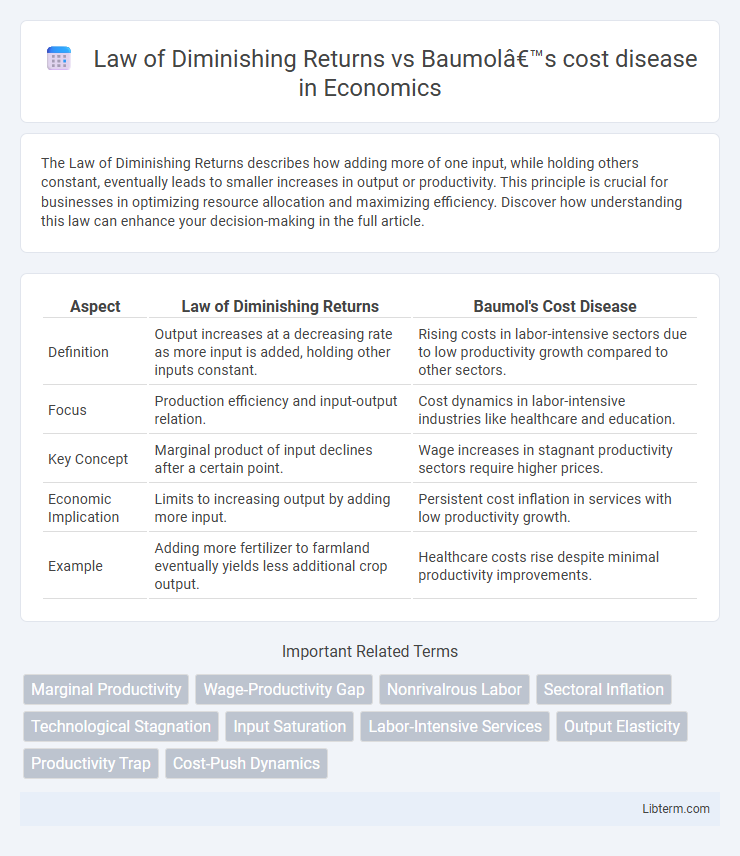The Law of Diminishing Returns describes how adding more of one input, while holding others constant, eventually leads to smaller increases in output or productivity. This principle is crucial for businesses in optimizing resource allocation and maximizing efficiency. Discover how understanding this law can enhance your decision-making in the full article.
Table of Comparison
| Aspect | Law of Diminishing Returns | Baumol's Cost Disease |
|---|---|---|
| Definition | Output increases at a decreasing rate as more input is added, holding other inputs constant. | Rising costs in labor-intensive sectors due to low productivity growth compared to other sectors. |
| Focus | Production efficiency and input-output relation. | Cost dynamics in labor-intensive industries like healthcare and education. |
| Key Concept | Marginal product of input declines after a certain point. | Wage increases in stagnant productivity sectors require higher prices. |
| Economic Implication | Limits to increasing output by adding more input. | Persistent cost inflation in services with low productivity growth. |
| Example | Adding more fertilizer to farmland eventually yields less additional crop output. | Healthcare costs rise despite minimal productivity improvements. |
Introduction to Economic Productivity Theories
The Law of Diminishing Returns explains that increasing input in production initially raises output but eventually yields progressively smaller gains, highlighting limits to productivity growth in traditional industries. Baumol's cost disease describes rising costs in labor-intensive sectors like education and healthcare due to stagnant productivity despite wage growth matching other sectors. These theories together illuminate challenges in sustaining economic productivity, stressing the need for innovation and efficiency improvements in diverse economic sectors.
Understanding the Law of Diminishing Returns
The Law of Diminishing Returns explains how increasing one input in production, while keeping others constant, eventually leads to smaller increments in output, causing efficiency to decline. This principle highlights the limits of productivity gains in industries with fixed technological factors. While Baumol's cost disease addresses rising costs due to stagnant productivity in labor-intensive sectors, the Law of Diminishing Returns concentrates on the fundamental constraints of input-output relationships in production processes.
Defining Baumol’s Cost Disease
Baumol's cost disease describes a phenomenon where wages in labor-intensive industries rise despite stagnant productivity, causing costs to increase without corresponding output gains. Unlike the Law of Diminishing Returns, which addresses decreasing output per input unit in production processes, Baumol's cost disease highlights structural challenges in sectors like education and healthcare. This effect explains persistent cost inflation in services where productivity growth lags behind wage increases driven by other more efficient industries.
Core Differences Between the Two Concepts
The Law of Diminishing Returns explains how increasing one input in production while keeping others constant leads to progressively smaller output increments, emphasizing efficiency constraints in physical goods. Baumol's cost disease highlights rising costs in labor-intensive service sectors due to stagnant productivity growth compared to other sectors with technological advancements. The core difference lies in the Law of Diminishing Returns addressing output efficiency in production processes, while Baumol's cost disease focuses on structural wage and cost disparities across economic sectors.
Historical Context and Economic Sectors Affected
The Law of Diminishing Returns, originating from classical economics in the 19th century, primarily impacts agriculture and manufacturing by highlighting how adding more of one input eventually yields lower per-unit output. Baumol's cost disease, formulated in the 1960s, affects service-oriented sectors such as education, healthcare, and performing arts, where productivity improvements lag behind wages that rise in more dynamic industries. This divergence explains why labor-intensive services face escalating costs despite stagnant productivity, contrasting with the diminishing returns seen in capital-intensive production.
Real-World Illustrations: Agriculture vs. Services
The Law of Diminishing Returns is evident in agriculture where adding more labor or fertilizer yields progressively smaller increases in crop output, reflecting physical resource constraints. Contrastingly, Baumol's cost disease is prominent in service sectors like education and healthcare, where productivity gains are limited due to labor-intensive tasks, causing rising costs despite stagnant output growth. Together, these concepts explain why agricultural productivity improvements reduce unit costs, while service sectors face escalating expenses despite technological advances.
Impact on Wage Growth and Price Inflation
The Law of Diminishing Returns leads to slower productivity growth in certain sectors, resulting in limited wage increases and restrained price inflation due to reduced output efficiency. Baumol's cost disease explains persistent wage growth in labor-intensive industries, such as education and healthcare, despite stagnant productivity, causing higher service prices and overall inflationary pressure. The contrast between these concepts highlights how wage growth in non-technological sectors drives price inflation, while diminishing returns constrain real income gains in others.
Policy Implications and Economic Efficiency
The Law of Diminishing Returns emphasizes that increasing inputs in production eventually leads to lower incremental output, informing policies that advocate for balanced input allocation to enhance productive efficiency. Baumol's cost disease highlights rising costs in labor-intensive sectors with stagnant productivity, prompting policymakers to consider subsidies or productivity-enhancing innovations in education and healthcare to maintain service quality without unsustainable expenditure growth. Understanding these concepts guides economic strategies that balance resource allocation, cost management, and public welfare optimization.
Challenges in Measurement and Analysis
Challenges in measuring the Law of Diminishing Returns arise from isolating variable inputs and quantifying productivity changes in diverse industries, complicating empirical validation. Baumol's cost disease poses difficulties due to the heterogeneity of labor productivity growth across sectors, making it hard to accurately attribute rising costs to stagnant productivity in service-oriented fields. Both theories require robust data and sophisticated econometric models to disentangle overlapping factors affecting output and costs, hindering precise policy analysis.
Concluding Thoughts: Navigating Productivity Dilemmas
The Law of Diminishing Returns highlights how increasing inputs yields progressively smaller output gains, challenging sustained productivity growth in traditional sectors. Baumol's cost disease explains rising costs in labor-intensive industries with stagnant productivity despite constant output, creating economic pressure to balance innovation and service delivery. Navigating these productivity dilemmas requires strategic investment in technology and human capital to optimize efficiency without compromising quality or accessibility.
Law of Diminishing Returns Infographic

 libterm.com
libterm.com